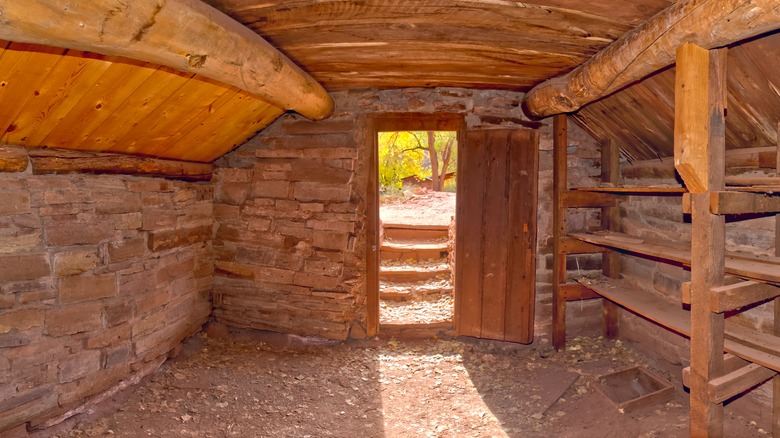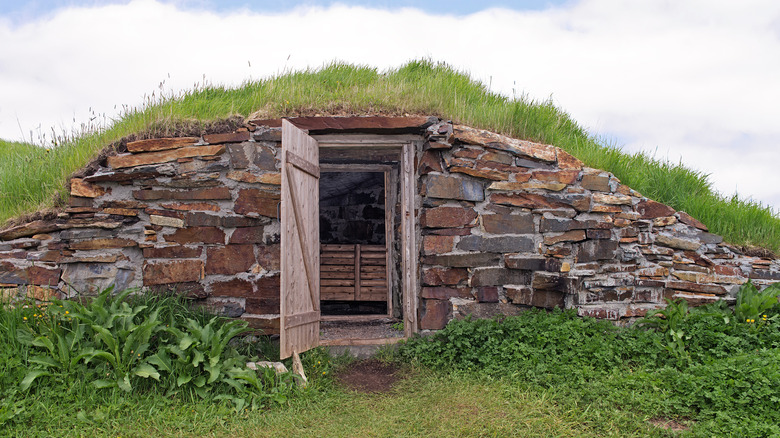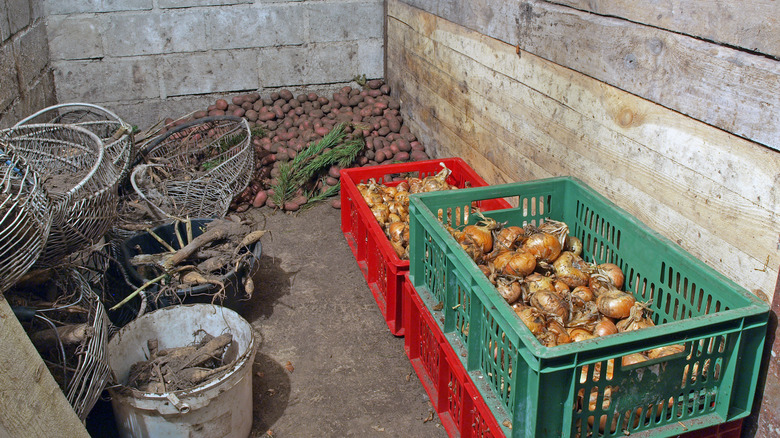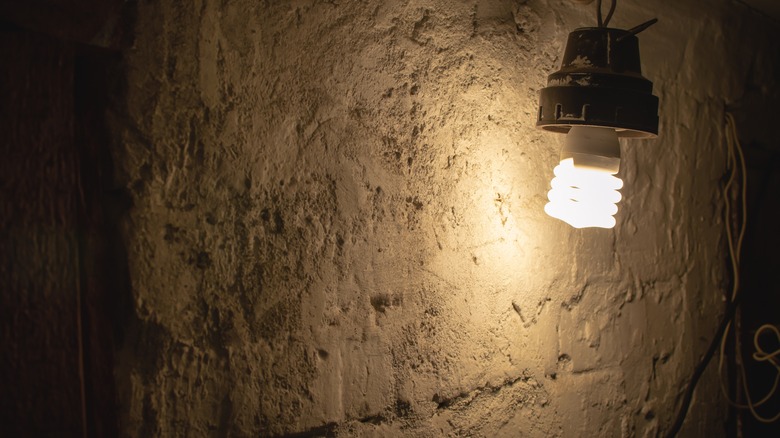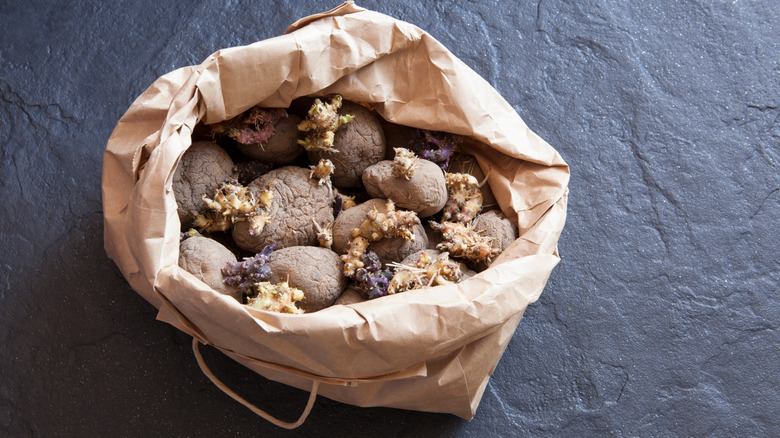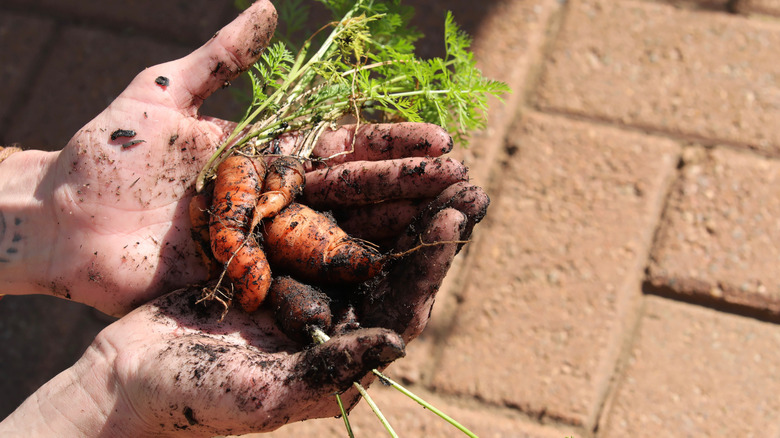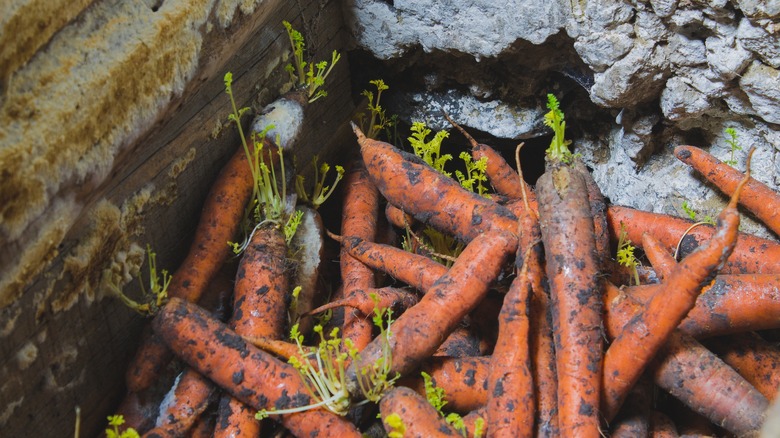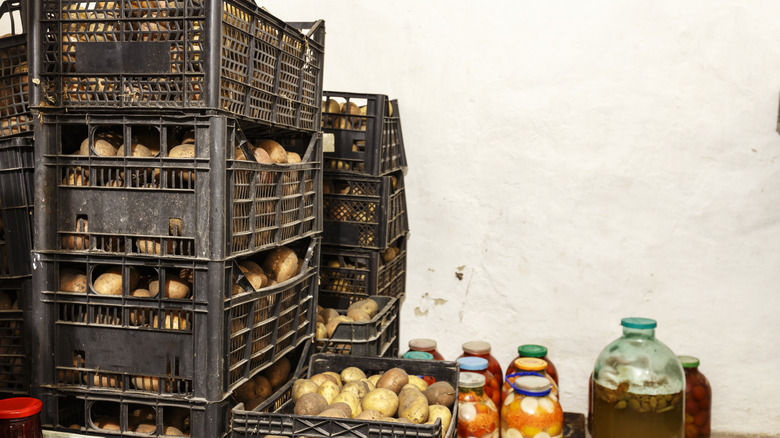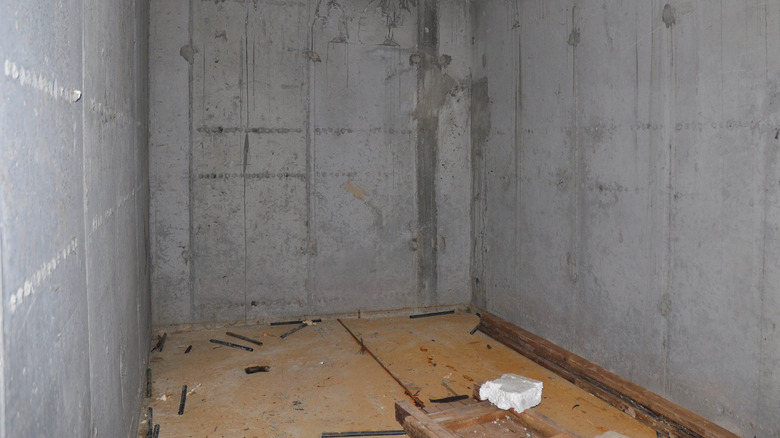7 Common Root Cellar Mistakes You Don't Want To Make
We may receive a commission on purchases made from links.
Before a strange combination of electricity and radiation came together to create refrigerators, did you ever wonder how the lettuce was kept crisp, a carrot firm, and an apple bursting with juicy goodness? The answer lies way underground in the shape of root cellars. Although modernism and all its marvels rendered them somewhat redundant, these economical and environmentally friendly spaces have enjoyed something of a resurgence in recent times. Root cellars are popular among people who value sustainability and self-sufficiency, and not just those who believe Armageddon is around the corner. However, if you're thinking of creating a root cellar on your property, there are some common mistakes you'll want to avoid.
For a root cellar to work, you need to successfully control its temperatures and humidity all year round. During the summer months, the food needs to stay free from rot and fresh enough to eat. During the heart of winter, your job is to stop it freezing and spoiling. It's easier said than done, and there are a range of things you need to take into consideration. What material are the floors made of? Is there adequate ventilation? And are you storing things properly? These are all questions you need to ask before you start converting your underground space into a root cellar or digging down and designing one from scratch. Let's make that journey below the earth's surface together and ensure the cellar of your dreams doesn't become that dark, damp, and claustrophobic hole of your nightmares.
The benefits of a root cellar
In an age of soaring energy costs and a growing awareness of climate change, the benefits of a root cellar are obvious. It relies on the earth to keep its own produce fresh for as long as possible. In times gone by, root cellars were the only way people could preserve potatoes, carrots, and other root vegetables safe for eating during the winter. You may ask yourself if you have a spacious enough refrigerator, do you really need a place deep underground to store your fruit and veg?
However, a cellar has the capacity to store the same amount as multiple refrigerators, and you don't have the added headache of the power failing and the food spoiling. This makes it perfect for gardeners who grow a lot of their own produce and need somewhere to store it. Additionally, over time it will save you a lot of money on your energy bills and shop-purchased food. Most people put shelves in their root cellars, which also makes them great places for storing canned goods and bottles of wine. A traditional walk-in root cellar that lies either beneath a structure such as a house or shed, or one that has been purposefully dug out of the earth and has its own door leading to it, all takes both finances and time to perfect. However, once it's built, it'll last longer than a lifetime and is a great way of getting back to basics and living a more simple and independent life.
Your floors are made of concrete
Any building from the Eifel Tower to a garden shed from IKEA is only as good as its foundation, and the same rings true for root cellars. Ideally, the best base for the floor of your root cellar is dirt. It's a room that has been dug out of the earth, so why complicate things? A plain dirt floor will help retain the natural moisture and allow it to circulate freely, which is good news for your stored produce. Scattering gravel on the dirt is recommended when it becomes too wet to walk on. You can later sprinkle it with more water if moisture levels drop. However, a dirt floor is only an option if you are in the process of excavating earth and digging out an outdoor root cellar. If, like most people, you are planning on converting a part of your existing basement, the chances are it already has a concrete floor. This can be problematic because concrete is designed to hold in heat and prevent moisture from circulating.
It's probably not advisable to smash up the concrete in a bid to optimize conditions. A basement with a concrete floor can still be used as a root cellar, you just need to be mindful that it is not as effective as a dirt floor. To create a basement root cellar, you'll need to wall off an existing corner. To combat the loss of humidity, you can either place containers of water on the concrete floor, protect the produce by covering it with damp burlap bags, or wrap them in moist sawdust or moss.
There's too much light
Although fruit and vegetables grow best in the sunlight, they last longer when stored in the dark places of the world. Never leave your root cellar lit up like a Christmas tree when you're not there because it can threaten the shelf life of your stored produce. Potatoes in particular are prone to discoloring and decay when exposed to too much light. It can also cause them to sprout unsightly growth and will leave a lot of fruit and vegetables washed out of both color and goodness.
To ensure your fruit and veg stay fresh and vital for as long as possible, you'll need to cover any windows and always remember to turn the lights off. Another handy hack is to use some burlap to protect your stock in case any light accidentally creeps in. Any overhead lights you do have in your root cellar should be very dim. Ideally, you should also use a flashlight on most occasions when you check on your produce. It's important to resist the urge to check on your root cellar every day because every time you visit, it lets a little more light in and upsets the temperature and humidity levels.
Not paying attention to its humidity or temperature levels
Without high humidity, your root cellar will not function properly. To prevent your produce from drying out and spoiling, you need plenty of moisture. (This is why some people throw a kitchen sponge into their fridge's produce drawer.) Additionally, it also needs to be cold enough to prevent the vegetables from releasing ethylene gas. Cool temperatures also slow microorganism growth, which can lead to early ripening and premature decay. However, maintaining optimal conditions in a room that needs to be cool with a certain degree of humidity is a tightrope walk. Cold air doesn't absorb moisture well (it's why you're always dry during the winter,) and if the temperatures in the room drop too much, all that excess moisture in the air will have nowhere to go. Pretty soon, you'll find condensation and damp patches forming on the walls and ceilings. When it inflitrates your produce, it can cause an epidemic of rot and mold, and it's pretty much game over.
To be effective, a root cellar must maintain a core temperature of somewhere between 30 to 40 degrees Fahrenheit. Root crops and vegetables mainly thrive in humidity levels of 85 to 95%. Therefore it's important to keep a close eye on the temperature and humidity levels. Thankfully, in the age of tech, we are spoiled for choice, and there's a wide range of pocket-sized, portable, and affordable devices we can use to ensure there are prime storage conditions in our root cellars. Some will even allow you access via your smartphone so you can keep a close watch on things 24-7. For example, the LEVOIT Smart Temperature Humidity Sensor will allow you to monitor both things on your cell.
You are washing rather than wiping the produce you store
Sometimes it's the simple things in life that trip us up. You may have been so busy focusing on your root cellar's light, temperature, and humidity levels that you've understandably overlooked the basics and fallen foul of a common mistake, such as washing as opposed to merely wiping the produce before you store it. Washing your vegetables before storing them can inadvertently create a bacteria hotspot by introducing all that excess moisture to your produce and cellar.
To be on the safe side, simply clean away any excess dirt from your produce before storing them. If they are particularly muddy during harvest and you are forced to wash them, ensure the water is no more than 10 degrees colder than the item you're rinsing. If it's colder than that, bacteria and microorganisms will push their way deeper into the produce to get away from the cold. You also want to thoroughly dry them with a paper towel before storing them. You can wrap your carrots, turnips, and other root vegetables in straw or slightly damp leaves to prevent the growth of bacteria. Obviously, right before you eat them is the perfect time to give them a good washing!
Not creating adequate storage space
There's nothing worse than creating a root cellar, harvesting your crop, and finding out you lack adequate storage space! In the ideal root cellar, there should be a place for everything and everything in its place. Not only does this make accessing a variety of fruits and vegetables easier, but it means you don't have the additional worry of the damage and rot that storing all sorts of fruit and vegetables cheek to cheek and shoulder to shoulder can do. Your produce needs room to breathe, so if it's carelessly slung onto piles or stacked in crates in claustrophobic conditions, you're in danger of holding the door open for mold and mice.
If you're serious about your root cellar, you'll need to install some shelves and storage bins to keep the produce box fresh. Ideally, they should be made of untreated and rot-resistant wood. Different strains of produce should be evenly spaced out and not touching one another to allow for natural air circulation. Place produce that thrives better in cold conditions, such as potatoes, on the bottom shelf and produce that does better in slightly warmer conditions, such as tomatoes, on the top shelf. Shelves should have adequate space between them and not be positioned flush to the wall to allow adequate airflow.
Your storage practices are all wrong
Once you've ensured that you're wiping as opposed to washing your produce and you have plenty of room to store it, there are still a few other things to bear in mind if you want your root cellar journey to be a successful one. For example, always keep the fruit and vegetables separate. Peaches and berries do not make good bed companions for vegetables such as potatoes and squash. The ethylene gas released by some varieties of fruit can limit the shelf life of vegetables.
Additionally, strong-smelling produce such as cabbage and onions have odors that can infiltrate fruit and leave it with an unpleasant taste. If you've already installed shelves and storage bins, it's a great way to segregate your crop. However, if you have the space, it's recommended to have separate cellars for both fruits and vegetables. Never make the mistake of thinking you can store produce in your root cellar and just forget about it. You need to be vigilant and keep checking if anything's spoiled so you can remove it before it causes bigger problems.
It lacks adequate ventilation and airflow
Ensuring your root cellar has the right amount of ventilation and airflow cannot be underestimated. All that ethylene gas that naturally circulates wherever large quantities of fruit and vegetables are stored needs an escape route. If stale air isn't allowed a suitable means of exit and there's no way for fresh air to enter, the produce will spoil fast. Ventilation is also invaluable in maintaining optimal humidity levels. Too little and the produce will shrivel up and dry out. Too much, and all that excess moisture can cause mold, mildew, and a premature end to your root cellar dream.
Ideally, you need two vents installed to let the air travel in both directions. It's advised to place outlet vents which will remove the hot, stale air, ethylene gases, and odors closer to the ceiling of your cellar. The vents that let in all that good, fresh, and cooler air should be installed closer to the ground to allow for the most beneficial airflow. If you remember the old physics lesson about warm air rising and cool air falling you won't go wrong. Placing the vents on opposite ends of the cellar will allow for maximum circulation and help keep your root cellar's temperature and humidity levels where they need to be.
